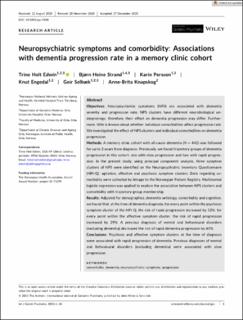| dc.description.abstract | Objectives Neuropsychiatric symptoms (NPS) are associated with dementia severity and progression rate. NPS clusters have different neurobiological underpinnings; therefore, their effect on dementia progression may differ. Further, little is known about whether individual comorbidities affect progression rate. We investigated the effect of NPS clusters and individual comorbidities on dementia progression. Methods A memory clinic cohort with all‐cause dementia (N = 442), was followed for up to three years from diagnosis. Previously, we found trajectory groups of dementia progression in this cohort: one with slow progression and two with rapid progression. In the present study, using principal component analysis, three symptom clusters of NPS were on the Neuropsychiatric Inventory Questionnaire (NPI‐Q): agitation, affective, and psychosis symptom clusters. Data regarding comorbidity were collected by linkage to the Norwegian patient registry. Multinomial logistic regression was applied to explore the association between NPS clusters and comorbidity with trajectory‐group membership. Results Adjusted for demographics, dementia aetiology, comorbidity, and cognition, we found that, at the time of dementia diagnosis, for every point within the psychosis symptom cluster of the NPI‐Q, the risk of rapid progression increased by 53%; for every point within the affective symptom cluster, the risk of rapid progression increased by 29%. A previous diagnosis of mental and behavioural disorders (excluding dementia) decreased the risk of rapid dementia progression by 65%. Conclusions Psychosis and affective symptom clusters at the time of diagnosis were associated with rapid progression of dementia. Previous diagnoses of mental and behavioural disorders (excluding dementia) were associated with slow progression. | |
